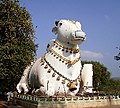Mahanandi
| Mahanandi | |
|---|---|
| State | Andhra Pradesh |
| District : | Kurnool |
| Main town : | |
| Residents : | 38,487 (2011) |

Mahanandi ( Telugu : మహానంది) is a mandal with almost 40,000 inhabitants in the Kurnool district in the Indian state of Andhra Pradesh . The district is named after a temple complex that is significant for the area. The mandal is divided into 9 villages: Basavapuram , Bollavaram , Bukkapuram , Gajulapalle , Gopavaram , Maseedupuram , Nandipalle , Thammadapalle and Thimmapuram .
location
Mahanandi is located about 18 km (driving distance) east of the city of Nandyal at the foot of the Nallamala Hills at an altitude of about 250 m above sea level. d. M. The district capital Kurnool is a good 90 km to the north-west.
economy
The inhabitants of the place live from agriculture, which is constantly supplied with sufficient water due to the nearby springs, and from (pilgrim) tourism, because Mahanandi is also surrounded by forests and also has an important Shiva shrine.
history
It is believed that the history of the place goes back very far because of the five springs in the area; Inscriptions from the 10th century mention several restorations of the temple.
Attractions
- The Mahanandiswara Swamy Temple , which was probably built around 1500 years ago, but was later changed again and again, is one of the most important sanctuaries in Andhra Pradesh - its current state dates from the Indian High Middle Ages ; the gate towers ( gopurams ) are much younger. It is especially famous for its temple ponds ( pushkarinis ), which are constantly supplied with fresh water from a spring below the Shiva temple. These waters are said to have healing powers for all kinds of illnesses and ailments, so that many pilgrims take a bath here. Pilgrims can touch the water in the cella ( garbhagriha ) equipped with lingam and yoni , which is unusual in India, since otherwise only the Brahmins have access to the most sacred temple area. The water is passed on from the temple ponds and used to irrigate the fields.
- The surrounding landscape with its forests and fields is ideal for walks.
- Surroundings
- Within a radius of about 15 km there are nine Nandi shrines ( nava nandulu ) that Indians like to visit - in particular, these are Mahanandi, Shivanandi, Vinayakanandi, Somanandi, Prathamanandi, Garudanandi, Suryanandi, Krishnanandi (also Vishnanandi ) and Naganandi .
Mahanandi Temple and Temple Pond
Largest Nandi statue in India
See also
The temple complex of Yaganti , located about 65 km to the west, was also built on a spring that continuously dispenses water.
Web links
- Mahanandi Temple - Photos + Info (English)


